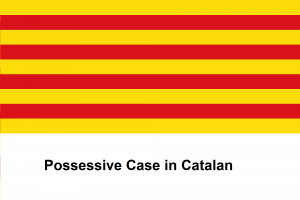Language/Catalan/Grammar/Possessive-Case-in-Catalan
Hi Catalan learners! 😊
In today's lesson, we will be discussing the possessive case in Catalan.
Introduction[edit | edit source]
The possessive case is a grammatical construction that indicates ownership or possession of something. In Catalan, the possessive case is formed by adding a possessive adjective to a noun. Possessive adjectives in Catalan agree in gender and number with the noun they modify. By understanding how to use possessive adjectives, you can describe ownership or possession in a clear and concise way.
Take some time to dive into these other pages after completing this lesson: Indefinite Articles in Catalan, How to say "there is" in Catalan, Verb to be with names and places & Genitive Case in Catalan.
Forms of Possessive Adjectives[edit | edit source]
Possessive adjectives in Catalan have different forms depending on the gender and number of the noun they modify. Here are the forms of the possessive adjectives in Catalan:
- "el meu" for singular masculine nouns
- "la meva" for singular feminine nouns
- "els meus" for plural masculine nouns
- "les meves" for plural feminine nouns
Here are some examples of how to use possessive adjectives in Catalan:
- "El meu cotxe és vermell." (My car is red.)
- "La meva germana té un gat." (My sister has a cat.)
- "Els meus amics són de Barcelona." (My friends are from Barcelona.)
- "Les meves germanes són bessones." (My sisters are twins.)
Placement of Possessive Adjectives[edit | edit source]
In Catalan, possessive adjectives usually come before the noun they modify. However, they can also come after the noun, particularly in more formal or literary contexts. When the possessive adjective comes after the noun, the definite article is used before the noun, and the possessive adjective is used in the form "de + possessive adjective." Here are some examples:
- "La casa meva és gran." (My house is big.)
- "La meva casa és gran." (My house is big.)
- "El meu cotxe vermell." (My red car.)
- "El cotxe meu vermell." (My red car.)
Other Uses of Possessive Adjectives[edit | edit source]
Possessive adjectives in Catalan can also be used in other ways to indicate ownership or possession. For example, they can be used with the preposition "de" to indicate the owner of something, or they can be used with a reflexive pronoun to indicate that someone is doing something to or for themselves. Here are some examples:
- "La casa de la meva tia." (My aunt's house.)
- "Vaig rentar-me les mans." (I washed my hands.)
Examples[edit | edit source]
| Word in English | Word in Catalan |
|---|---|
| MY (MAS) | EL MEU |
| MY (FEM) | LA MEVA |
| MY (MAS / PLUR) | ELS MEUS |
| MY (FEM / PLUR) | LES MEVES |
| YOUR (MAS) | EL TEU |
| YOUR (FEM) | LA TEVA |
| YOUR (MAS / PLUR) | ELS TEUS |
| YOUR (FEM / PLUR) | LES TEVES |
| YOUR (MAS / FORMAL) | EL VOSTRE |
| YOUR (FEM / FORMAL) | LA VOSTRA |
| YOUR (MAS / PLUR / FORMAL) | ELS VOSTRES |
| YOUR (FEM / PLUR / FORMAL) | LES VOSTRES |
| HIS | EL SEU |
| HER | LA SEVA |
| THEIR (MAS / PLUR) | ELS SEUS |
| THEIR (FEM / PLUR) | LES SEVES |
| OUR (MAS) | EL NOSTRE |
| OUR (FEM) | LA NOSTRA |
| OUR (MAS / PLUR) | ELS NOSTRES |
| OUR (FEM / PLUR) | LES NOSTRES |
Conclusion[edit | edit source]
The possessive case is an important part of Catalan grammar, and it is essential to understand how to use possessive adjectives in order to describe ownership and possession. By paying attention to the gender and number of the noun being modified, and by understanding the different ways that possessive adjectives can be used, you can improve your communication skills in Catalan.
If you have any questions, please ask them in the comments section below.
Feel free to edit this wiki page if you think it can be improved. 😎
Other Lessons[edit | edit source]
- Gender
- Adjectives
- How to use the Modal Verb Must in Catalan
- Indefinite Articles in Catalan
- Plural
- Ordinal Numbers in Catalan
- Definite Articles in Catalan
- Cardinal Numbers in Catalan
- Nominative Case in Catalan
- Nouns

